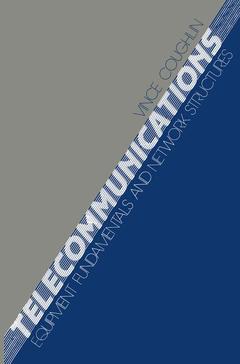Telecommunications, Softcover reprint of the original 1st ed. 1984 Equipment Fundamentals and Network Structures
Langue : Anglais
Auteur : Coughlin Vincent J.

Modern technology began in the 1950's and 1960's, with the devel opment of transistor technology. At first it was useful in improving the performance of voice communications. But then it made possible extraordinary computer capability in manageable size-and at man ageable cost. First came large mainframe computers for only the largest companies; and later the microcomputer as we know it today. The increasing use of computers, in the 1960's with their ability to manipulate and store vast quantities of information, stimulated the need for computers to communicate with one another and so tele phone circuits had to be segregated and conditioned specifically for computer traffic, using the modem. Computers ushered in a new era of business communications in which data could be developed, ma nipulated, stored or transmitted with remarkable ease. The recent pace of technological advancement has been breath taking and, today, the distinction between communications and computers is no longer even necessary. Computers, at the very core of communications networks, route and control communications on major common carriers. The decade of the 1980's is bearing the fruits of the marriage of computers and communications. For the first time networks are en abling organizations to utilize the combined processing power of computers and communications equipment.
1. The Medium and the Market — An Overview.- 1.1 A Telecommunications Overview.- 1.2 Understanding the Basics.- 1.3 A Bright Future with Fiber Optics.- 1.4 A View from the Business Side.- 2. Modems and Multiplexers.- 2.1 Introduction.- 2.2 The Role of Modems.- 2.3 Modem Applications.- 2.4 Industry Standards.- 2.5 Modem Features.- 2.6 Multiplexing Reduces Communications Cost.- 2.7 Multiplexer Technology.- 2.8 Statistical Multiplexer.- 3. Protocols and Codes.- 3.1 What is a Protocol?.- 3.2 Protocol Hierarchy.- 3.3 Physical Electrical Interface.- 3.4 Link Control Structure.- 3.5 Bisync Protocol.- 3.6 HDLC Protocol.- 3.7 SDLC Overview.- 3.8 System Network Architecture (SNA).- 3.9 Polling Explained.- 3.10 Transmission Codes.- 3.11 Code and Speed Converters.- 3.12 Treatment of Errors.- 3.13 Front-End Processors.- 4. Terminal Technology.- 4.1 CRT Display Terminals.- 4.2 Printing Technologies.- 4.3 Graphic Terminals.- 4.4 Facsimile Technology.- 4.5 Integrated Workstations.- 5. Network Management.- 5.1 Network Control Design Considerations.- 5.2 Elementary Monitoring.- 5.3 Redundancy and Compatability.- 5.4 Network Testing.- 5.5 Centralized Troubleshooting.- 5.6 Network Control Center.- 5.7 Specialized Test Equipment.- 5.8 Network Security.- 6. Network Structures.- 6.1 Topology Tradeoffs.- 6.2 Local Area Networks.- 6.3 Distributed Communications.- 6.4 Message Switching Networks.- 6.5 Integrated Voice and Data.- 6.6 Shared Resources.- 6.7 Packet Switching Networks.- 6.8 Network Design Considerations.- 7. Satellite and Carrier Services.- 7.1 Satellite Overview.- 7.2 Selecting a Transmission Method.- 7.3 Facsimile Services.- Glossary of Terms.
Date de parution : 03-2012
Ouvrage de 132 p.
15.2x22.9 cm
Mots-clés :
Ethernet; LAN; Multiplexer; Standards; communication; information; network design; satellite; telecommunications; transparency
© 2024 LAVOISIER S.A.S.



